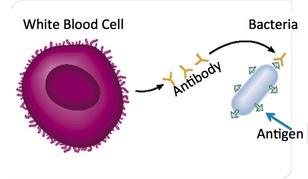
The body’s collective defence measures are known as the immune system. This works by identifying and targeting pathogens. Over time, the body remembers some germs and gives immunity so the same diseases do not return.
Antibodies
The body makes weapons called antibodies. These defensive chemical proteins attach themselves to invaders to identify them as enemies for white blood cells to eat.
Armies of antibodies
When the body recognizes a pathogen, about 10,000 trillion antibodies are released into the bloodstream and attach themselves to the known germs.
- Firstly, the antibodies neutralise the virus, meaning that it is no longer capable of infecting the host cell.
- Secondly, many antibodies can work together, causing virus particles to stick together in a process called agglutination. Agglutinated viruses make an easier target for immune cells than single viral particles.
- A third mechanism used by antibodies to eradicate viruses, is the activation of phagocytes. A virus-bound antibody binds to receptors, called Fc receptors, on the surface of phagocytic cells and triggers a mechanism known as phagocytosis, by which the cell engulfs and destroys the virus.
- Finally, antibodies can also activate the complement system, which opsonises and promotes phagocytosis of viruses. Complement can also damage the envelope (phospholipid bilayer) that is present on some types of virus.
Picture Credit : Google

